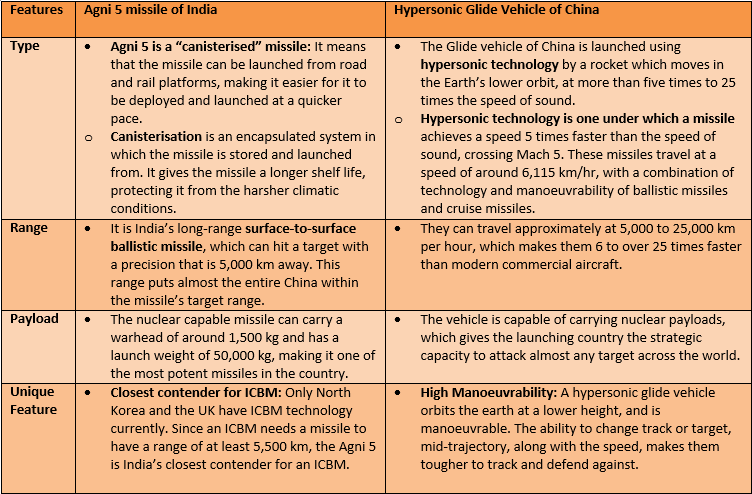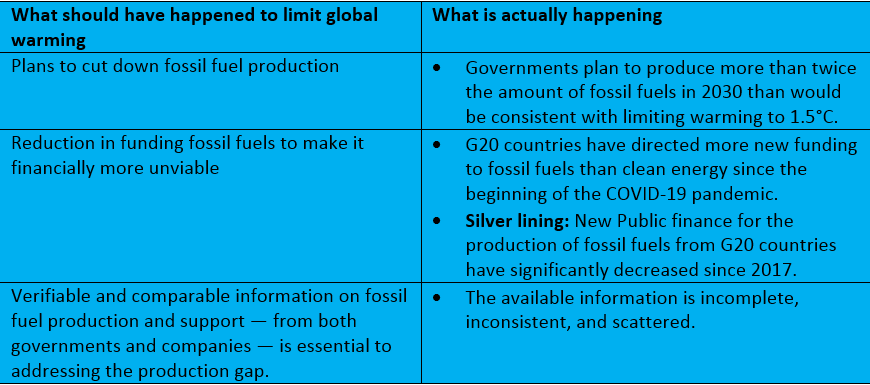Monday, 1st November 2021
G-20 Summit, 2021
In News
G20 leaders’ recent meeting in Rome committed to the key goal of limiting global warming to 1.5 degrees Celsius and pledged action on the use of coal, but fell short on a target of zero emissions.
About the news
- Importance of G20 pledges: The pledges by the Group of 20 major economies, who emit nearly 80% of carbon emissions, are viewed as crucial to the success of COP26, at Glasgow.
- India at G20: Commerce Minister of India hailed the communique for acknowledging India’s concerns on climate justice.
- India managed to safeguard the interest of developing countries by ensuring that the statement acknowledges that developed nations need to deliver on affordable finance and innovative technology.
- Decisions made at the G20 meeting, 2021
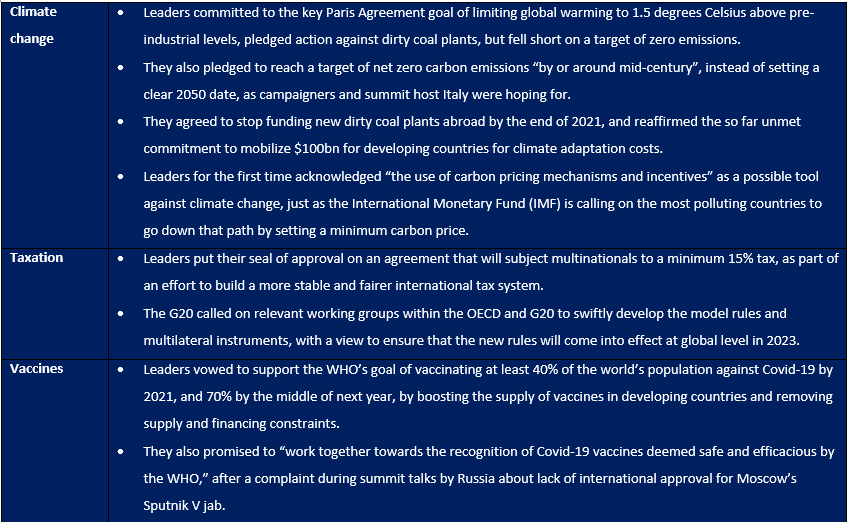

What is missing in the G20 communique?
- Net Zero Deadline: There was no consensus on deadline for net zero emission targets. The final communique, spoke only of the key relevance of achieving global net zero on carbon emissions by or around mid-century.
- Domestic Commitments: No mention on domestic commitments to end coal power generation.
- Pathways to Goals: The pathway to achieve the goal was not clear in the statement. Under current national climate commitments, the world is on track for a temperature increase of 2.7 degrees Celsius by the end of the century.
Sources:
Rise in Farmer Suicides
In News
The number of agricultural labourers who died by suicide in 2020 was 18% higher than 2019 as per National Crime Records Bureau (NCRB)’s report ‘Accidental Deaths & Suicides in India, 2020’.
About the Farm Suicides in 2020
- Farm Suicides: About 7% of all suicides in the country in 2020 was committed by people engaged in the farm sector, slightly higher than that in 2019.
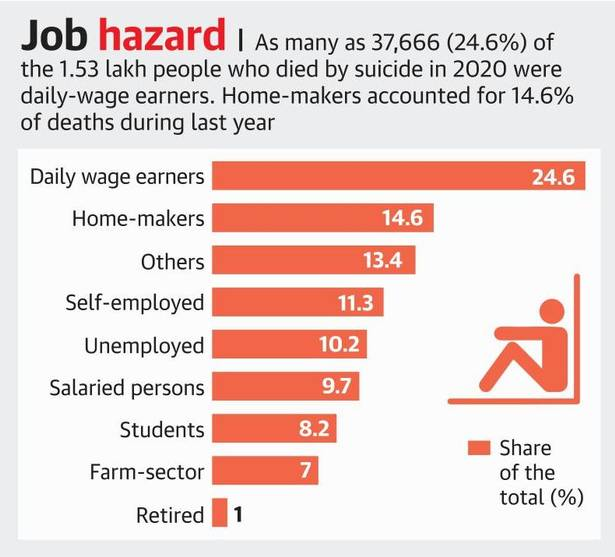
- Among farmers who cultivate their own land, with or without the help of other workers, the number of suicides dropped by 7%.
- Among tenant farmers who cultivate leased land, there was a 23% drop in suicides.
- Agriculture as a primary source: Most of these deaths were among those whose primary work and main source of income comes from labour activities in agriculture or horticulture.
- Irony: The farm sector was one of the few bright spots in the Indian economy in 2020 because of healthy monsoon and the continuation of agricultural activities during the lockdown.
- Reason for distress: The NCRB report does not include any indication of the specific causes of suicide among the farm community.
- However, landless agricultural labourers who did not benefit from income support schemes such as PM Kisan may have faced higher levels of distress during the pandemic.
- State wise impact: Maharashtra reported most suicides (4,006) from the farm sector, including a 15% increase in farm worker suicides.
- Other states such as Karnataka (2,016), Andhra Pradesh (889), Madhya Pradesh (735) have reported higher suicides.
- Karnataka saw a 43% increase in the number of farm worker suicides in 2020.
- Andhra Pradesh was among the few States that saw an improvement, with 14% fewer people in the farm sector dying by suicide.
Other finding of the NCRB report
- The NCRB report divides suicides into nine categories — daily wagers, housewives and people working in the farm sector, professionals/salaried persons, students, unemployed, persons, self-employed persons, retired persons, and others.
- Suicides in India rose 10 per cent from 2019 to an all-time high of 1,53,052 in 2020, with student suicides seeing the highest percentage increase at 21.20 per cent.
- Daily wage earners made up the largest share of total suicides at 37,666 in 2020
Source:
Amendments to Energy Conservation Act, 2001
In News
The Ministry of Power has proposed amendments to Energy Conservation Act, 2001 to boost renewable energy consumption.
About the News
- The Government has identified new areas to achieve higher levels of penetration of renewable energy through certain amendments to Energy Conservation Act, 2001 to address the growing energy needs and the changing global climate
- The objective will be to enhance demand for renewable energy at the end-use sectors such as industry, buildings, transport etc.
- With the amendments, the focus is to empower institutions to contribute for Paris commitments and fully implement NDCs in a timely manner.
Provisions of the Amendments
- Share of Renewable energy consumption: The minimum share/quantum of renewable energy in the overall consumption either directly or indirectly through grid by the industrial units or any establishment will be defined under the amendment.
- There will be provision to incentivise efforts on using clean energy sources by means of carbon saving certificate.
- This will help in reduction of fossil fuel based energy consumption and carbon emission to the atmosphere.
- Promotion of Green Hydrogen: The provisions facilitate promotion of green Hydrogen as an alternate to the existing fossil fuels used by the Industries.
- Sustainable Habitat: The proposal also includes expanding the scope of Act to include larger Residential buildings, with an aim to promote Sustainable Habitat.
How will the proposed amendments be beneficial?
- Carbon Credits: The additional incentives in the form of Carbon credits against deployment of clean technologies will result in private sector involvement in climate actions
- Carbon Market: The proposed amendments would facilitate development of Carbon market in India. This will help in reduction of fossil fuel based energy consumption and carbon emission to the atmosphere.
- Adoption of clean technologies: The proposed changes to the EC Act will boost the adoption of clean technologies in various sectors of economy.
- This will enable India to achieve its target of reducing emission intensity by 33-35% in 2030 against the levels of 2005 as per its commitment to Nationally Determined Contributions (NDCs).
Salient features of Energy Conservation Act, 2001
This act gives the power to the central government and in some cases, the state also gets the power to:
- Fix the energy usage standards for specific appliances and equipment.
- Give direction that there should be a mandatory display of labels specific equipment and appliances.
- Stop the building, import, and sale of the items which are not to the standards.
- Inform energy concentrated businesses, different foundations, and business structures as assigned customers
- Set up and recommend energy utilization standards and guidelines for assigned buyers
- Prescribe or make changes in Energy Conservation Building Codes (ECBC) to local conditions for energy conservation and efficient use of energy in a new commercial building with a contract load of 500 kW.
- Make and provide Central and State Energy Conservation Fund
Source:
Emissions Gap Report 2021
In News
The ‘Emissions Gap Report 2021: The Heat Is On’ has been recently released by the UNEP
About the News
- The Emissions Gap Report 2021: The Heat Is On is the 12th edition in an annual series that provides an overview of the difference between where greenhouse emissions are predicted to be in 2030 and where they should be to avert the worst impacts of climate change.
- The Emissions Gap Report 2021 shows that new national climate pledges combined with other mitigation measures put the world on track for a global temperature rise of 2.7°C by the end of the century. To keep global warming below 5°C this century, the world needs to halve annual greenhouse gas emissions in the next eight years.
- Nationally determined contribution (NDC): Submissions by countries that have ratified the Paris Agreement which presents their national efforts to reach the Paris Agreement’s long-term temperature goal of limiting warming to well below 2°C.
- New or updated NDCs were expected to be submitted in 2020 and should be submitted every five years thereafter. NDCs thus represent a country’s current ambition/target for reducing emissions nationally.
Key Findings of the Report
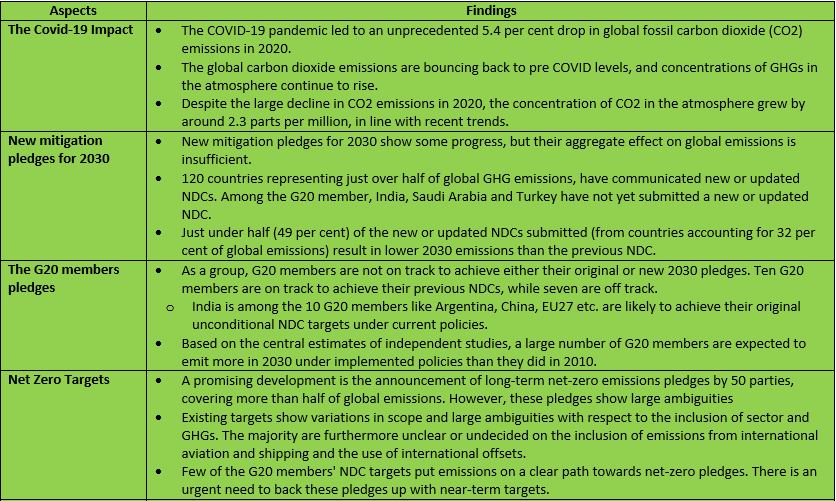
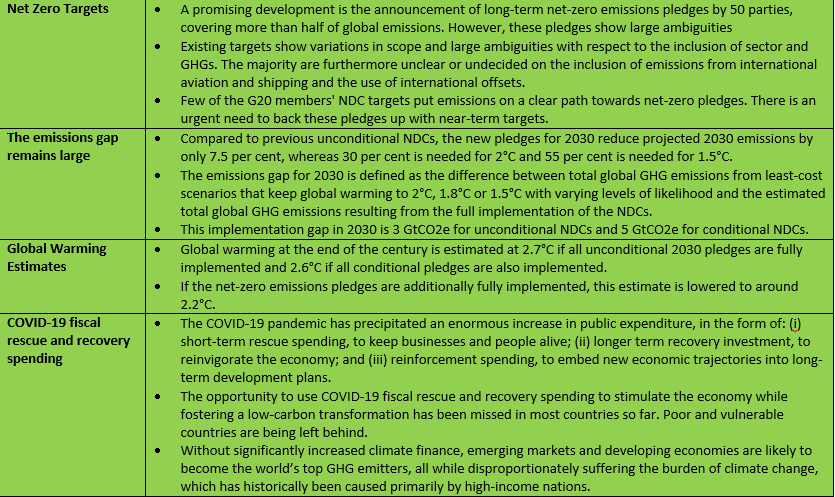

But, there are pathways for a Green Recovery
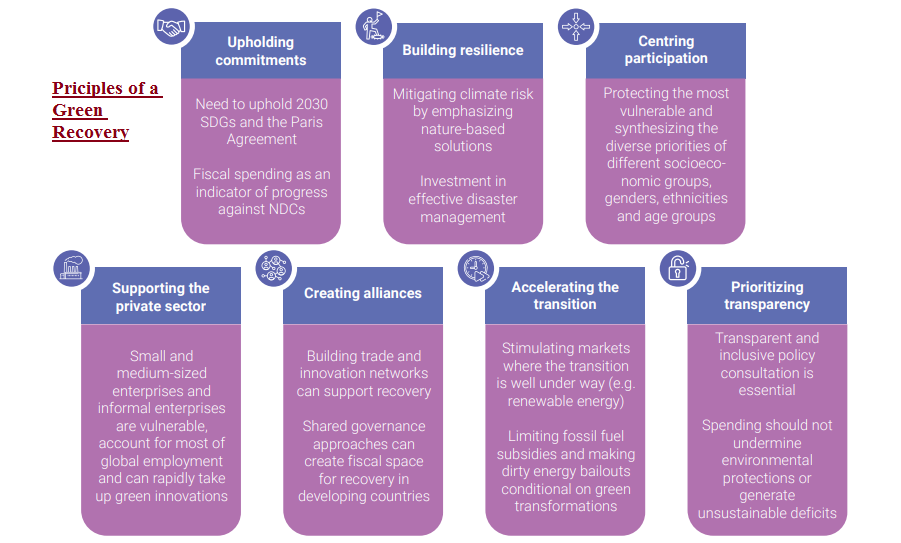
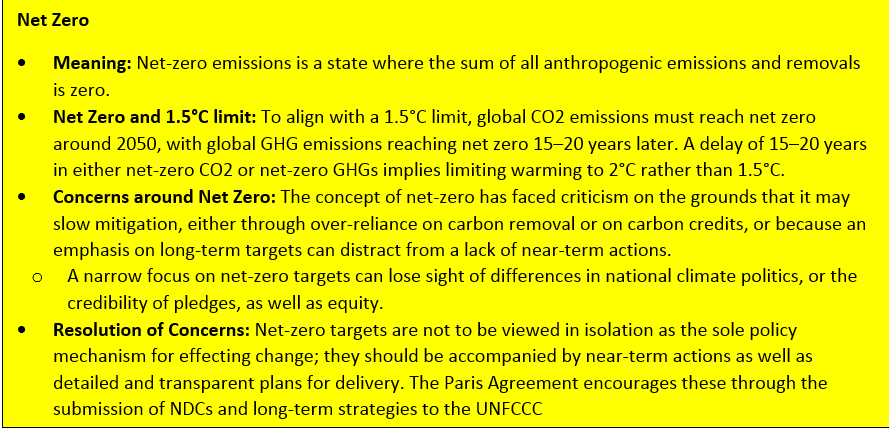
Conclusion: Climate action so far has been characterized by weak promises, not yet delivered. As the Emissions Gap Report 2021 shows, the updated nationally determined contributions (NDCs) under the Paris Agreement fall into the same trap. These pledges only take 7.5 per cent off predicted 2030 emissions, compared to the previous round of commitments. This is far from adequate. Reductions of 30 per cent are needed to stay on the least-cost pathway for 2°C and 55 per cent for 1.5°C.
Question: Discuss the major gaps in the emission status of the world. What can done to mend the gaps?
Sources:
This Day in History - Queen’s proclamation
On November 1, 1858, a grand Darbar was held at Allahabad. Queen’s proclamation to the "Princes, Chiefs, and People of India" also known as the ‘Government of India Act 1858’ was issued by Queen on this day. Lord Canning announced Queen Victoria’s proclamation to “the Princes, Chiefs and Peoples of India,” which unveiled a new British policy of perpetual support for “native princes” and non-intervention in matters of religious belief or worship within British India. The announcement reversed Lord Dalhousie’s pre-war policy of political unification through princely state annexation, and princes were left free to adopt any heirs they desired so long as they all swore undying allegiance to the British crown. The document was called “Magna Carta of the People of India” and declared that the principles of justice and religious toleration will act as the guiding policy of the queen’s rule.
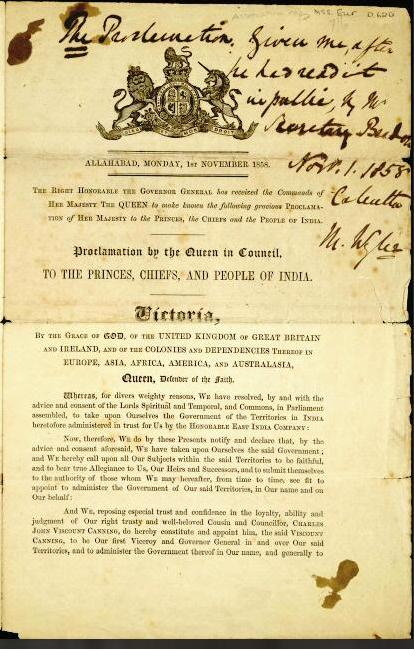
Source:
Image of the Day - National Unity Day
National Unity Day or Rashtriya Ekta Diwas is celebrated on October 31 every year. The Government of India introduced the day in 2014 to mark the birth anniversary of Vallabhbhai Patel, the first Deputy Prime Minister and Home Minister of independent India. Vallabhbhai Patel was dubbed “Sardar” (chief) for his leadership skills in leading the country through the struggle for independence and beyond, and most notably during the integration of the princely states and the India-Pakistan War of 1947. For his commitment to the national integration of the newly independent country, Sardar Patel earned the sobriquet “Iron Man of India”. On National Unity Day, a pledge is read out in government offices, public sector undertakings (PSUs), and other public institutions in accordance of an official order by the government.
Sources:
India’s First Indigenous Long-Range Bomb
- Context: An Indian Air Force (IAF) team and the DRDO have successfully flight-tested the long-range bomb (LRB) from a Sukhoi-30 fighter jet over Balasore in Odisha.
- LRB is India’s first indigenously developed bomb and is part of the class of weapons with a range of 50 to 150 km.
- It can carry a warhead of 1000 kilograms.
- The bomb has been designed and developed by DRDO’s Research Centre Imarat (RCI) laboratory in Hyderabad, in coordination with other DRDO laboratories.
- The successful test of the LR Bomb makes India capable of staying well within its territory and hitting enemy targets at 100 kilometres with high accuracy.
Source:
Hydrological Status and Outlook System (HydroSOS)
- Context: An operational global system named (HydroSOS) has been launched by the World Meteorological Organisation (WMO).
- HydroSOS is an operational global system capable of assessing the current status of surface and groundwater hydrological systems, or for predicting how they will change in the near future.
- Formulated in 2017, it is a global consortium working at both global and regional/national levels that intends to unify existing approaches into a workable harmonised system.
- The System will be delivered by National Meteorological and Hydrological Services (NMHSs), offering simple, accessible hydrological information to users such as government bodies, basin managers, funding institutions, aid agencies, UN bodies, and the general public.
- It will regularly report:
- The current global hydrological status, including groundwater, river flow and soil moisture;
- An appraisal of where the current status is significantly different from ‘normal,’ for example indicating potential drought and flood situations; and
- An assessment of whether this is likely to get better or worse over coming weeks and months.
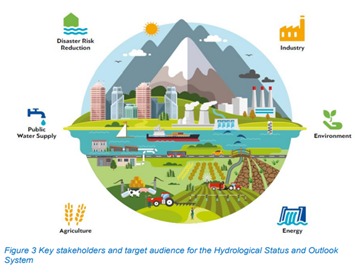
Source:
Flash Flood Guidance System
- Context: The Flash Flood Guidance System (FFGS) has been launched to address the issues associated with flash floods.
- Flash floods are among the world’s deadliest natural disasters which costs more than 5,000 lives annually. They differ from river floods in their short time scales and occurrence on small spatial scales.
- FFGS is a robust system designed to support the development of flash flood warnings from rainfall events using remote-sensed precipitation (that is, radar and satellite-based rainfall estimates) and hydrological models.
- It is necessary to provide operational forecasters and disaster management agencies with real-time informational guidance relating to the threat of small-scale flash flooding.
- Its other objectives include:
-
- Enhance the capacity of National Meteorological and Hydrological Services (NMHSs) to issue effective flash flood warnings and alerts;
- Foster national and regional development and collaboration;
- Provide extensive training, including online training, to forecasters; and
- Support the WMO Flood Forecasting Initiative.
- FFGS with global coverage was approved at the Fifteenth WMO Congress.
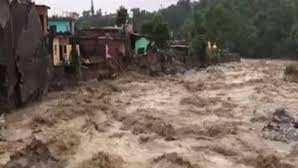
Source:
Why India needs a Ministry of Energy: IE
Essence: The article highlights the pressing need to reconsider the entire Energy sector responsibility mechanism. The need arises in the light of the coal crises which the country witnessed in recent times. Due to structural gaps, there is no one ministry and body at the Centre to oversee the responsibility and accountability for the entire coal value chain. For this reason, various ministries involved in the process kept on passing the blame to each other. In order to resolve this structural lacuna, the author proposes two suggestions.
First is an act that could elevate the significance of energy by granting it constitutional sanctity. Second is Ministry of Energy to oversee the currently isolated verticals of the ministries of petroleum, coal, renewables and power. This will not only have a positive impact on the investor sentiment but will also handle all of the issues that currently fall between the cracks created by the existing structure.
Why you should read this article?
- To understand the lacunae in energy policy of India.
To understand what steps should be taken to improve the gaps in the management of energy in the country.
Source:
There’s a mismatch between India’s graduate aspirations and job availability: IE
Essence: The article states that the majority of the college students in India are from modest socio-economic background. They come from villages or small towns and belong to farming families, families with first generation of college-goers and with an income less than 5 lakh rupees a year. The enhanced enrolment of students from these socio-economic backgrounds is primarily a result of the extension of reservations to OBCs and EWS.
According to the article, majority of the students aspire for government jobs. But, there is a mismatch between the job demand and supply. Jobs are generally contractual in nature. One solution to this crisis is to improve the quality of the vocational institutions (Industrial Training Institutes). The curriculum of them needs to be updated to include newer skills such as maintaining networking and telecom equipment.
Why you should read this article?
- To know about the socio-economic background of college students in India.
- To understand the reasons for huge pool of unemployed university graduates with unfulfilled aspirations.
- To know about the measures the government can take to fulfil the aspirations of the graduates.
Source:
Getting nutrition back on the school high table: TH
Essence: As educational institutions are re-opening we need to ensure nutrition of children so that they are armed with good immunity against COVID- 19 as they are not yet in the ambit of the vaccination drive. India faces multiple problems of under-nutrition and overweight/obesity coexisting with deficiencies of micronutrients such as iron, zinc, calcium and several vitamins.
For this we need to take following steps like- One, identifying & addressing the triple burden of malnutrition especially in the case of children and adolescents. Second, to understand disruptive social environment factors that affect diet quality. Hence, we need to ensure that children consume a balanced diet with adequate diversity to provide them with a solid foundation for an active and healthy life. The Pradhan Mantri Poshan Shakti Nirman Yojana (PM- POSHAN) is setting a broad base & covering students of pre-primary levels & government aided primary along with primary and upper primary school children. Good immunity will lay the foundation for long-term well- being & schools should be avenues for teaching nutrition as a life skill than rhetorical pedagogy.
Why should you read this article?
- To understand the importance of balanced diet among children & what steps we need to take to ensure the same.
- To know what are the steps taken by the government in this regard.
Source:
Cycling over City
Background
- Transportation is an important part of the daily lifestyle, especially for the working people.
- South Delhi Municipal Corporation has initiated the installation of e-cycle docking stations around 80 locations for supplementing the services.
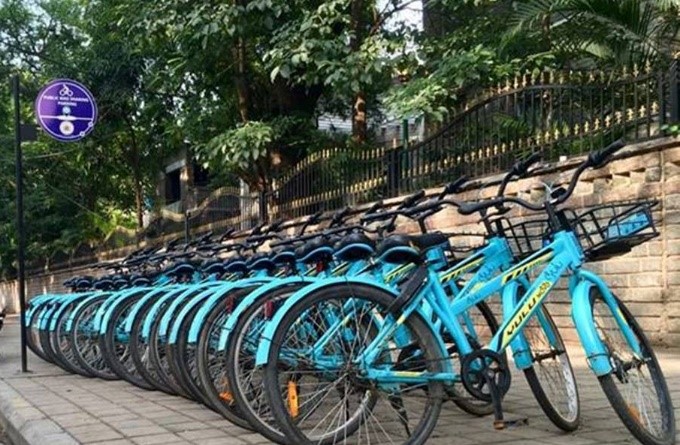
How e-cycling is becoming a norm?
- As most part of the city is connected through metros, the commutation from metro station becomes a never ending struggle.
- With the launch of the e-cycle docking, stations around the residential areas, parking lots and metro stations, the usability of these vehicles will rise.
- These cycles run on battery, hence the condition of fuel conservation and environmental safeguard will also be addressed through this.
- Health benefits of cycling is numerous, hence this will further encourage people to take up cycling.
Quote: Every time I see an adult on a bicycle, I no longer despair for the future of the human race.-H.G. Wells
Sources:
Share the article
Get Latest Updates on Offers, Event dates, and free Mentorship sessions.

Get in touch with our Expert Academic Counsellors 👋
FAQs
UPSC Daily Current Affairs focuses on learning current events on a daily basis. An aspirant needs to study regular and updated information about current events, news, and relevant topics that are important for UPSC aspirants. It covers national and international affairs, government policies, socio-economic issues, science and technology advancements, and more.
UPSC Daily Current Affairs provides aspirants with a concise and comprehensive overview of the latest happenings and developments across various fields. It helps aspirants stay updated with current affairs and provides them with valuable insights and analysis, which are essential for answering questions in the UPSC examinations. It enhances their knowledge, analytical skills, and ability to connect current affairs with the UPSC syllabus.
UPSC Daily Current Affairs covers a wide range of topics, including politics, economics, science and technology, environment, social issues, governance, international relations, and more. It offers news summaries, in-depth analyses, editorials, opinion pieces, and relevant study materials. It also provides practice questions and quizzes to help aspirants test their understanding of current affairs.
Edukemy's UPSC Daily Current Affairs can be accessed through:
- UPSC Daily Current Affairs can be accessed through Current Affairs tab at the top of the Main Page of Edukemy.
- Edukemy Mobile app: The Daily Current Affairs can also be access through Edukemy Mobile App.
- Social media: Follow Edukemy’s official social media accounts or pages that provide UPSC Daily Current Affairs updates, including Facebook, Twitter, or Telegram channels.

